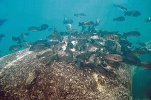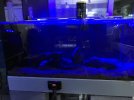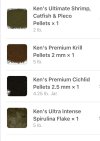Yes. In the wild both male and female
Tropheus establish territories that are primarily feeding grounds where they graze on algae. Dominant males have the largest territories, with abundant algae, and their breeding strategy is to entice a receptive female into that territory, where she will graze
ad libitum for several weeks until she is full of eggs, and receptive to spawning. After spawning, she leaves his territory to incubate the embryos on her own for ~4 weeks, often in the company of other brooding females, before releasing a small number of well-developed fry, all of which are the progeny of that single male. This is unusual amongst Tanganyikan mouthbrooders, most of whom incubate multipaternal broods.
There is no way to recapitulate these behaviours in captivity, because even our largest tanks are don't provide enough space. And unlike Mbuna,
Tropheus are basically open-water fishes that don't require rock caves for shelter. Given these facts, my
Tropheus tanks have minimal rock work, just enough to (i) provide shelter for any adults that might be the targets of undue aggression, and (ii) give fry and juveniles places to hide whilst growing to sizes (~1") large enough to join the main colony. Those tanks tend to look like this; there isn't a great deal to fight over-













